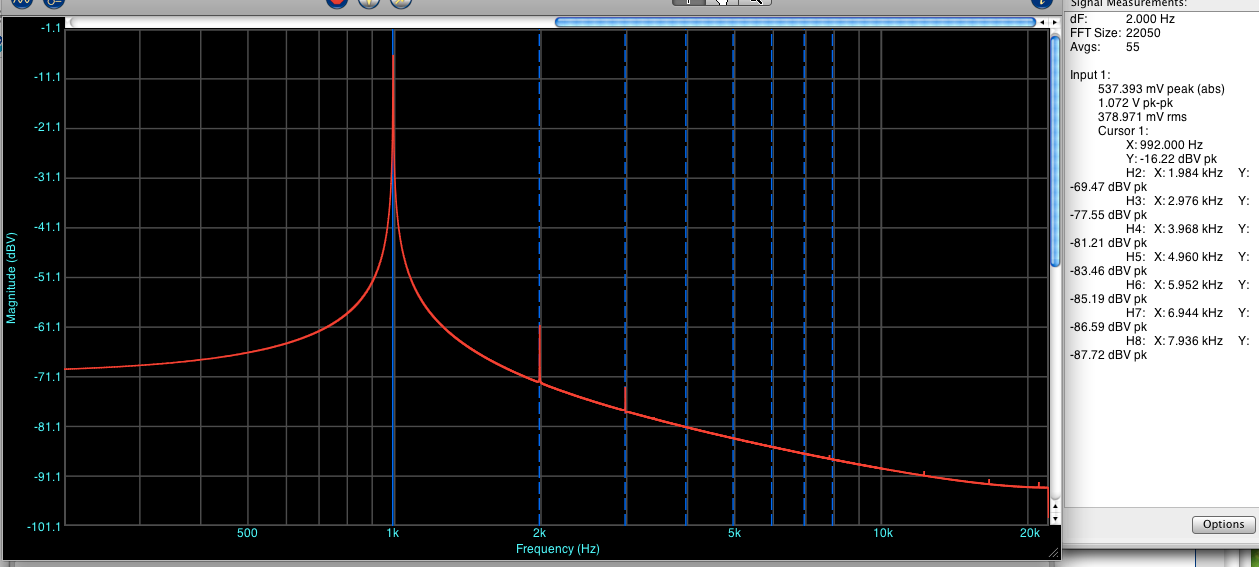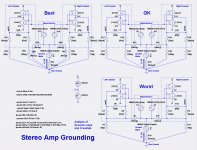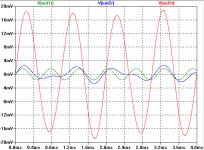You can experiment with the adjustments and listen. Of course you will not know exactly what spectrum looks like.If you don´t have a spectrumanalyzer is it best to not use the zen pots then?
No. Hook up your spectrum analyzer and go through the exercise. It might be more subtle with the F6, but that is the effect that I see with the F6CC.Hi Lhquam,
Didn't you mean H2 after the first dot instead of H3?
Distortion Analyzer Setup
http://www.diyaudio.com/forums/pass-labs/216616-f6-amplifier-436.html#post3516349
http://www.diyaudio.com/forums/pass-labs/216616-f6-amplifier-436.html#post3516349
Thanks,maybe later when I have finnished the F6 and decided if toif you want I can help you installing this......
use the pots or not..
Thanks,maybe later when I have finnished the F6 and decided if to
use the pots or not..
you are welcome!
I have done some analysis of alternative star grounding schemes for F5, F6, ... type amplifiers. Since this is a rather generic issue, to what thread does it belong? Without explanation here is an LTSpice schematic and some crosstalk + ground noise waveforms.
Attachments
Can you briefly explain what is the simplest/cheapest way to set up either my Mac or old PC laptop as a distortion analyzer?
Yes! It's simple! - I posted a solution a few pages back; Follow the links, that's where all the information is.
~~~
"But Jim, I don't have a distortion analyzer! How can I measure and set the pots?"
That is painfully simple, once the secret is let out. (Thank you Generg and Tea-Bag)
Make one of these - Electronic Equiptment - DIY soundcard scope probe
Connect it across a 4- or 8-ohm dummy load resistor on the output of your amp. Feed your amp a nice 1KHz sinewave. Adjust the pot so that you send no more than a 1V signal to the computer input.
Plug into your computer mic input and use a FFT program like this audioTester or this SignalScope (One is PC, one Mac)
You will have resolution that was only dreamed about 30yr ago, and can adjust the distortion visually, looking at the 2nd and 3rd harmonic peaks on the FFT plot.

Taken from another thread about bias vs. distortion, but cleanly shows the fundamental at 1K, and the harmonic peaks at 2 and 3K.
~~~
The trick to this isn't the FFT, it's the input sinewave. There are a couple ways to do this -
Soundcard - If you have a computer that has a dedicated soundcard, getting a test tone out of it shouldn't be that hard.
Test Generator - Craigslist and a hundred bucks should get you a good one. Anything from the late 70's or newer should be fine. Tek and HP stuff will be a bit more.
CD or other input - There are websites with test tones you can download, then rip a CD or file to an iPod, and just use that as the tone.
24bit, 48kHz is enough to get a fair impression!
Most build in sound cards can do this.....
And you can choose this value in Windows under settings- sound-- forgot the rest, you will find......
You have to choose these values for output (speaker) and input (microphone)
Most build in sound cards can do this.....
And you can choose this value in Windows under settings- sound-- forgot the rest, you will find......
You have to choose these values for output (speaker) and input (microphone)
Last edited:
Question for you folks, who have distortion analyzer: what FE jfet degeneration does with distortions and spectra?
As far as I can say...
Very similar to output degeneration of F6...
K3 is mostly a fix value and degeneration on the side of the J74 or K170 gives more or less K2 of negative or positiv phase.
Total Harmonic Distortion will augment of course in these cases...
But you can minimize K2 and get the lowest THD also....
There are two different effects from degeneration in the complementary JFET input stage:
BTW: The resistor values that give the lowest THD will not be the same as those that zero the output offset voltage.
- Reducing the bias current through JFETs, in order to reduce power dissipation. With the drains connected to 24V rails, this becomes important.
- Cancelling H2 by careful choice of resistor values. In general they will have different values.
BTW: The resistor values that give the lowest THD will not be the same as those that zero the output offset voltage.
As far as I can say...
Very similar to output degeneration of F6...
K3 is mostly a fix value and degeneration on the side of the J74 or K170 gives more or less K2 of negative or positiv phase.
Total Harmonic Distortion will augment of course in these cases...
But you can minimize K2 and get the lowest THD also....
Last edited:
- Home
- Amplifiers
- Pass Labs
- F6 Amplifier

